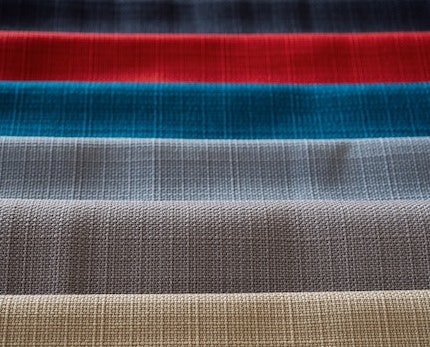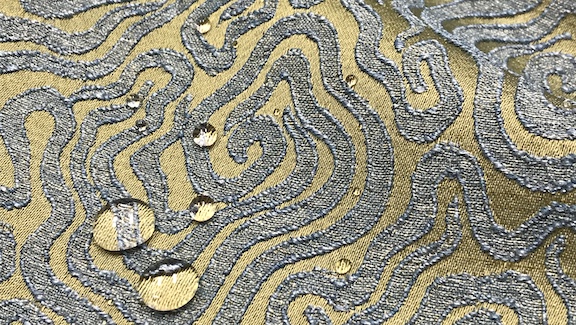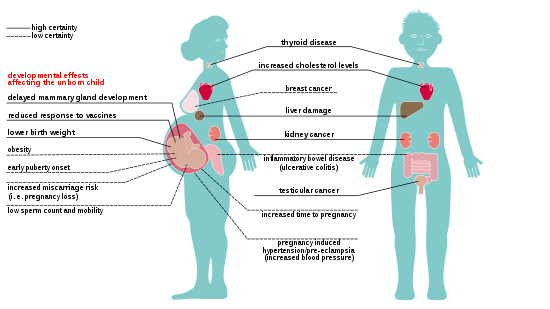Questioning the safety of chemicals used in upholstery fabrics

Upholsterers & designers offer a fabulous array of performance fabrics… at what cost? (Image: Vitalijs Barilo – Unsplash)
Upholsterers, designers, and architects are being called more and more to understand the underlying chemistry of the materials they are specifying, AND to question its safety. This is the first in a series of posts examining the hazards of toxic ingredients found in upholstery, and what you can do to protect your clients’ and your family’s health.
Professional workrooms and designers have access to a wide range of performance fabrics in gorgeous colors, textures and patterns. Most commercial end-users, such as restaurants, hotels and hospitals, have come to regard performance fabrics as essential, because of their ability to stand up to hard use, while repelling dirt, liquids, cleaning chemicals, and pathogens.
Homeowners often seek fabrics that will hold up to the everyday activities of children & pets. It’s understandable.
Reupholstery is not cheap, and of course you want your furniture investment to last.

(Image: Adam Stefanca – Unsplash)
“Less waste!” and “Longer lasting!”
Performance fabrics are expected to hold up to hard use, and longevity is an important consideration for commercial decision-makers watching their bottom line by minimizing reupholstery costs. Aside from financial considerations, there are valid ‘green’ arguments for anything that prolongs the life of the furniture, and reduces the necessity for cleaning chemicals.
The buzz word today is sustainability, and companies’ marketing reflects the ‘we mean to be green’ sentiment.
Of course there ARE certain performance fabrics that confer stain & moisture repellency without the use of PFAS chemicals (Olefin, for example) – a subject that warrants closer examination in a future post.
The TRUE COST of PFAS Stain & Moisture Repellents
Long-term Health and Environmental Impacts
Unfortunately, there’s a serious underlying problem with the use of PFAS stain repellant chemicals in upholstery fabrics. The time has come for every one of us – professional or homeowner to ask ourselves: “Is the convenience of stain repellent fabric worth the potential for harm?”
How stain repellants work
When used as fabric treatments, stain repellants reduce the surface tension on the textile so that liquids and oils bead up rather than spreading out and soaking through the fibers. Dirt and oils sit on the surface, where they can be easily wiped away. Maintenance requires fewer cleaning chemicals, and the fabric lasts longer, saving resources.

Nano-Tex fabric with (likely) PFAS-C6 water & stain repellent treatment
Less cleaning chemicals and longer lasting fabrics are a measure of sustainability, BUT… we have come to point where we must seriously question the consequences.
What are PFAS?
PFAS represents a family of over 4,500 perfluorinated and polyfluorinated alkyl chemicals. PFAS are man-made chemicals that do not exist in nature. These chemicals work as stain repellents due to the extremely strong bond between carbon & fluorine, which does not break. It is the strongest chemical bond in the periodic table. Arlene Blum points out that “it takes the energy of lightning to break this bond”. These are “forever chemicals”.
We’re talking geologic time.
Millions . Of . Years
The same quality that endows these compounds with the miraculous ability to repel stains and oils also makes them persistent – in our bodies, and in the environment.
Where are PFAS used in upholstery?
The most notable use of PFAS is in fabric stain repellants. You may have heard of PFOS, the C8 chemical and active ingredient in 3M’s Scotchgard treatment – the C8 product was banned in 2002. The C6 and the C4 chemicals (‘regrettable substitutions’) that have since replaced the C8 technology are no better in terms of their persistence, and are very likely just as hazardous to our health due to their association as a Class of chemicals.
PFAS are the active ingredients in textile treatments such as:
- Scotchgard
- Crypton
- GreenShield
- Nano-Tex
- …and many others
Chemical stain repellants used in fabric today (early 2021) are likely to be fluorinated C6. Fortunately, that seems to be changing rapidly, thanks to the work of the Green Science Policy Institute, and others working to bring attention to the problem of chemicals in our home & work environments.
Why we should be concerned
Decades after the introduction and subsequent wide use of these chemicals in products we use in our homes every day, the price of what was previously perceived as a wonderful convenience has come to light in the form of widespread health problems.
“The best-studied PFAS, PFOA and PFOS, are linked to liver damage, high cholesterol, obesity, diabetes, cancer, thyroid disease, asthma, immune system dysfunction, reduced fertility, low birth weight, and effects on children’s cognitive and neurobehavioral development.”
– Green Science Policy Institute
How we are exposed
Humans are exposed to PFAS through contaminated food, drinking water, air and dust.
- PFAS may be shed from fabrics (and many other home goods) during use, or after disposal in a landfill. These chemicals are extremely persistent, meaning they do not ever break down in the environment.
- The chemicals end up in dust in our homes, and we may unknowingly ingest them.
- Toddlers playing on the floor are constantly putting hands to mouth.
- PFAS chemicals leach from landfills or are flushed, and end up contaminating wells & drinking water. Although they can be removed by drinking water treatment plants, they currently can NOT be removed by wastewater treatment plants.
- PFAS are found in the bodies of 99% of Americans.
- PFAS move with the natural water cycle – through rivers to the ocean, through groundwater into wells, and have even been found in remote corners of the globe (such as the arctic & antarctic)
What is being done today?
Scientific studies have shown that PFAS is a serious threat to human health and the environment. Entire municipal water systems have been polluted by factories, with dire consequences for the communities which depend on them (check out the film ‘Dark Waters’ based on a true story).
The problem with toxic chemicals like PFAS is a lack of regulation. There is only one law related to regulating chemicals in products: the Toxic Substances Control Act (TSCA) of 1976*. Consider that:
- 62,000 chemicals that were already in use a the time this law went into effect were ‘grandfathered’.
- Of 22,000 new chemicals that have come in to use since then – 85% have no health data & 67% have no data at all.
- This is all to say the burden of proof of harm lies with the EPA, and ultimately the consumer (due to the language of the law and EPA’s lack of resources to test the thousands of chemicals already in use).
“The EPA has been successful in restricting only five chemicals under this act (PCBs, chlorofluorocarbons, dioxin, asbestos, and hexavalent chromium) in its 38-year history, with the ban on asbestos being overturned in 1991″ (Wikipedia).
[*Note: there are numerous laws related to regulating chemicals in various matrices: products, food, drinking water, air and waste. TSCA is more or less the only law related to regulating chemicals in products. Thanks to GPSI for this Clarification].
What can YOU do NOW?

(image: Brett Jordan-Unsplash)
Protect your health & the environment, AND initiate change
Follow the Sustainable Furnishings Council’s guidance:
- Ask your legislators for regulations for safer chemicals – in furniture as well as in other consumer products.
- Be alert, and ask questions about what stain repellent chemicals are used in the fabric. Be specific: Ask if PFAS (Perfluorinated & PolyFluorinated Alkyl Substances) are in the fabric. PFAS includes not only C8 (which is banned), but also C6 and C4 (which are still in use). Ask for a response, whether making inquiries with a fabric supplier, design firm, upholstery workroom, or at a local furniture store. This helps move the issue into the offices and Board rooms of top decision-makers, rather than letting it die at the retail level.
- Join SFC’s “What’s it made of?” Initiative.
The importance of asking questions about what things are made of cannot be over emphasized. Adding your voice helps support a market for eco friendly products and reinforces the need for manufacturers and dealers to provide more options. – Susan Ingles, SFC
What’s your definition of ‘Essential’?

(image: Marisa Howenstine-Unsplash)
Whether you’re specifying products for a client or your own home, and considering products that contain a chemical stain repellent (which is very likely to be PFAS), first ask yourself and/or your client:
- Is it necessary?
- Is it worth it?
- Is there a safer alternative for me right now, to serve my need?
Final considerations:
- Choose textiles that are naturally stain- and water-resistant, such as wool (a natural fiber without added chemicals).
- Choose textiles without water- and stain-repellency, whenever possible.
- Note that a “PFOA free” claim on products refers only to C8, which is banned, and these products often use similar chemicals instead.
- Support companies that are committed to phasing out highly fluorinated chemicals (see GSPI’s list of PFAS-free products).
Links:
The National Upholstery Association is working to improve education, opportunities, and build awareness, initiate change, sustainability initiatives for greener upholstery choices. You can join or sign up for their mailing list here. If you’re a member you can watch Patty Grossman’s webinar (4/14/20) which has been summarized (with some omissions) in this related post:
Related post: ‘Green’ Choices in Upholstery Fabric (is there such a thing?)
Thanks to Building Green and Green Science Policy Institute for providing excellent resources regarding these chemicals.
Join NaturalUpholstery.com’s mailing list to receive our newsletter featuring news from the upholstery community, health trends in furniture, and resources for natural choices in upholstery materials.


Carla, Are there any outdoor upholstery fabrics (outer material) that are non-toxic? I’ve gone to all the trouble to make what’s inside my house mostly non-toxic, but I have three custom cushions to make for a built in patio seat, and I keep putting the project off hoping I’ll find something other than Sunbrella. I think I can use latex foam and wool batting and cotton ticking fabric since it’s far under an eave and not subject to rain.
Thanks!
Hi Angela,
You might try hemp, which is naturally resistant to UV damage. Hemp Traders has some nice options. Good luck!
Thank you for this info. Is it possible for an upholstery fabric to be Greenguard Gold Certified and still be treated with PFAS?
Hi Kristen,
I believe that it IS possible for Greenguard Gold certified fabric to contain PFAS. I found this reference to Greenguard in which a UL Environment (entity that administers the Greenguard certification) spokesperson states “PFCs would be very unlikely to show up as VOC’s in our testing since they tend to be very large, heavy chemicals that are unlikely to off-gas. There is limited concern about these types of chemicals affecting indoor air quality which is what GREENGUARD is concerned about.” Read the article for further clarification. That said, there ARE Greenguard certified fabrics that do not contain PFAS (also known as PFCs) – Breathe by Milliken is one that is flourine-free.